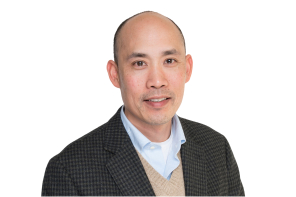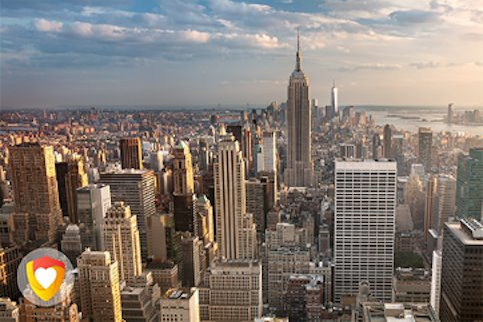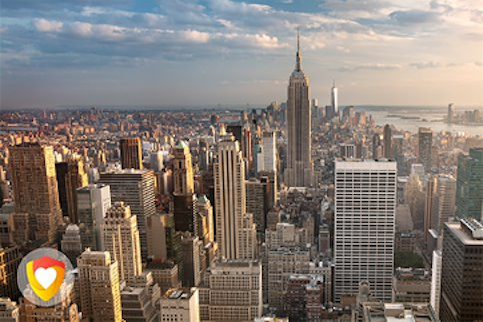Q: What inspired you to volunteer with all the risks involved?
Hartwell Lin, MD: On the West Coast, we were preparing for the pandemic wave to hit, and it never really happened. Although we were grateful, I and many others had also heard the stories from colleagues in New York and wanted to help and learn from the experience. As an emergency physician, my instinct is to go where the patients need me, knowing that it would also benefit the overworked and exhausted providers who desperately needed a break. Once I decided to volunteer, I gave my shifts to colleagues who were eager to take them since ED volumes were so low in California at that point.
Q: What have you learned about COVID-19 as a disease from this experience?
HL: We’re working on a formal report for the California Governor’s Office, so there will be more to come on this. But clinically, one of the things that is most striking is how patients can look normal but actually be quite sick.
In emergency medicine, you often rely on visual cues of the patient’s physical symptoms to track how they’re doing. That doesn’t work for patients who are sick with COVID. They might be looking you in the eye, speaking but slightly out of breath, but then the pulse oximeter says 78% oxygen saturation. That’s one of my biggest lessons – both to know that the normal visual cues may not accurately represent the patient’s condition, but also to make sure practice sites have enough pulse oximeters that are easy to use. For this disease, it almost takes place of the stethoscope as the most helpful diagnostic tool.
Q: How did your family feel about your decision to go to New York to provide COVID-19 clinical relief?
HL: At first my family thought I was nuts. But I reminded them that coronavirus is everywhere. You’re more likely to get it at your local grocery store if you’re not using proper precautions than you are in a hospital with full personal protective equipment (PPE). I had already seen COVID patients at the hospital where I work, and I felt confident that I would be protected by essentially wearing full-time PPE while on shift in New York. I wasn’t naïve enough to say there were no risks, but life is all about risk and reward. New York City needed help.
It was a little strange to make the practical arrangements before I left, like showing my wife where the life insurance policy was. I know a few other colleagues updated their wills before leaving on this trip, so we were all aware of the gravity of the situation.
As for my mom, I didn’t tell her I was in New York until the last day. She’s still mad at me but she’ll get over it eventually.
“All the medication we take for granted – they ran out. Ventilators? They were all different makes and models. Nothing prepares you for that. You just put your head down and persevere. That doesn’t come from training, that’s sourced from human spirit.”
Hartwell Lin, MD
Vituity Delegation Leader
Q: Did you know what to expect once you signed up?
HL:We received the call about the opportunity on a Thursday from a fellow physician partner, Tom Sugarman, MD.
Initially 40 Vituity providers volunteered, but only 14 were needed for the first wave. All the volunteers were credentialed within 36 hours to work at the hospitals in New York thanks to the licensing waiver currently in place. By the following Thursday, 14 of us were there. It all happened quickly.
Even during our flight, it wasn’t clear what to expect once we got there. I met with the Department of Medicine Chair to talk about my role. From there it was highly variable each day, depending on the needs of the hospital. Most days I was rounding the general floors screening for COVID patients that may be decompensating, and then for a few days I was the primary attending in the intensive care unit (ICU). I worked every day I was in New York – days, nights – you’re there to help, to serve in whatever capacity you can.
Q: As the lead of the Vituity delegation, what were some of your responsibilities while in New York?
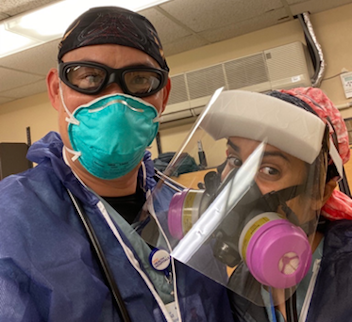
HL: We had a few practical concerns going into the opportunity. We couldn’t assume that their resources are the same. Although we were assured that there was enough PPE for everyone, as the leader on the ground, I was checking in to ensure everyone had enough gear.
Since we went into this with short notice, I also wanted to make sure that our providers were being utilized effectively. The last thing we wanted was to have them sitting in a hospital with a high prevalence of COVID and not adding value. If they weren’t needed at a given location, we could work with the central health system to transfer them to a practice site where they would be more useful.
I think we all approached this with varying levels of anxiety. There was a tremendous amount of camaraderie within our group to begin with, and my most important role was to make sure everyone felt supported and connected while so physically removed from home and colleagues. Before we left, I made a request with New York leadership that all our physicians work at their designated hospitals in teams, so that no one was at a location alone. We scheduled virtual check-ins and I encouraged them to keep a journal and write down their experiences and feelings.
Now that I am back, I’ve also been supporting the later waves of clinicians from Vituity who have deployed to New York, including more emergency physicians, advanced providers, and psychiatrists.
Q: You mentioned that you were running the ICU for a few days. As an emergency trained physician, what was that experience like?
HL: I did rotations in the ICU when I was a resident, and let's just say that was a long time ago. And I had never managed one before as the primary attending. While I was in the ICU in New York I was overseeing 13 critically ill COVID patients who were either intubated or on significant respiratory support. As the lead person for a group of volunteer physicians from the military and team of residents, I had to call the shots.
You have to understand that the hospital I worked at – and the others my Vituity colleagues supported – had been completely transformed by COVID. There were numerous floors converted to ICUs, and despite that, we still had spillover of critical COVID patients onto the general floors. So, for those few days, I was the most qualified physician to lead that particular ICU.
I was incredibly fortunate to have the resources and support of Vituity’s critical care team. I had attended a webinar series shortly before I left, developed by Vituity physician partner, Ian Butler, DO, called, “Stepping Into the ICU”. As COVID-19 revealed itself as a virus that landed many in the ICU in respiratory distress, Ian rightly wanted to educate fellow clinicians with this CME-accredited series to expand their knowledge base should they need to step into roles outside of their specialty. The webinar was incredibly helpful to reorient to the physiology and lingo.
But to be clear, I was more than happy to hand over leadership to a critical care physician after a few days. I know who the pros are.
Q: Did your emergency medicine training and experience prepare you for this type of patient care?
HL: The surge had ended about two weeks before we arrived, so my role most of the time was to round on the floors of the hospital, which were full of seriously ill patients, and identify those that weren’t doing well and raise an alarm. That type of triage is definitely in the emergency medicine wheelhouse and was incredibly valuable while most of the care teams were focused on patients already in critical condition.
Others in our first wave of deployment worked fulltime in ICUs in partnership with intensivists because EM training is more directly translatable to the critical care setting. But we’ve also received the same feedback from Vituity nurse practitioners who deployed in a later wave to COVID testing clinics in New York City. Their emergency medicine experience has helped them be incredibly adaptable and efficient at managing the high patient volumes in a setting like this.
Q: Do you have any regrets about volunteering in New York during the coronavirus pandemic? Any surprises?
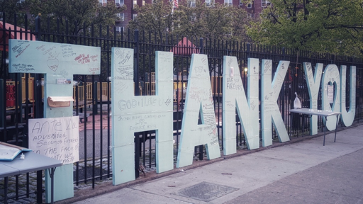
HL: If I had a regret, it’s that I wish we had been there when the patient surge was highest. I heard stories from that time, and like many of the places hardest hit by the pandemic, no-one was prepared.
When you train, you assume you have a certain amount of resources on hand – but in a situation like this, there is the risk that you run out of everything. All the medication we take for granted -- they ran out. Ventilators? They were all different makes and models. Nothing prepares you for that. You just put your head down and persevere. That doesn’t come from training, that’s sourced from human spirit.
I think that might be the one thing that surprised me – how much the local teams in New York were able to persevere through the surge and come out the other side. I have so much respect for the truly heroic work they did, and I’m glad I was able to work shifts that let them get some extra rest and relieve the burden they carried for so many weeks.
Q: What would you tell others about the New York experience?
HL: This disease has moved so quickly, and our understanding of it was changing almost by the day in April at the time I was deployed. Serving at the epicenter was incredibly valuable to learn and experience information real time. I am now much more comfortable treating COVID patients and have been able to bring this experience back to my local hospital and to my Vituity colleagues.
But we couldn’t have done this without Vituity’s support. The team really made this happen, from managing licensing and credentialing to hotels and flights. All we had to do was get on a plane and focus on the care of patients.
Q: What about all the public accolades and appreciation? How does that feel right now?
HL: In emergency medicine, we’ve always taken care of patients regardless of their circumstances. We have always been the safety net for the communities we serve. We are the primary care providers for the population that doesn’t have one. We don’t second guess anyone who comes in with a fever, a scratch, or chest pain. We’re always there.
And we’re here right now in emergency departments and inpatient units across the country. I appreciate all the recognition healthcare providers have been receiving. But it’s really important that people don’t delay care even during this crisis. We know there are victims of this pandemic who were not infected with coronavirus, but had conditions worsen because they did not seek care. We are here for you now and will always be here for you.
For more about how Vituity is poised to lead the response to COVID-19 .






